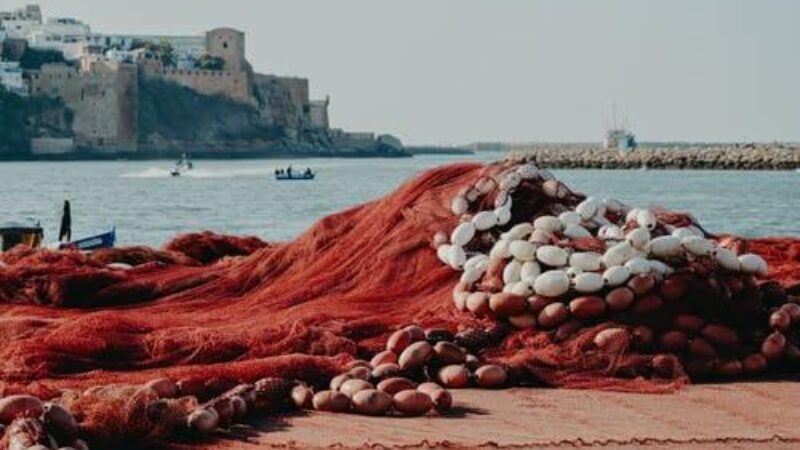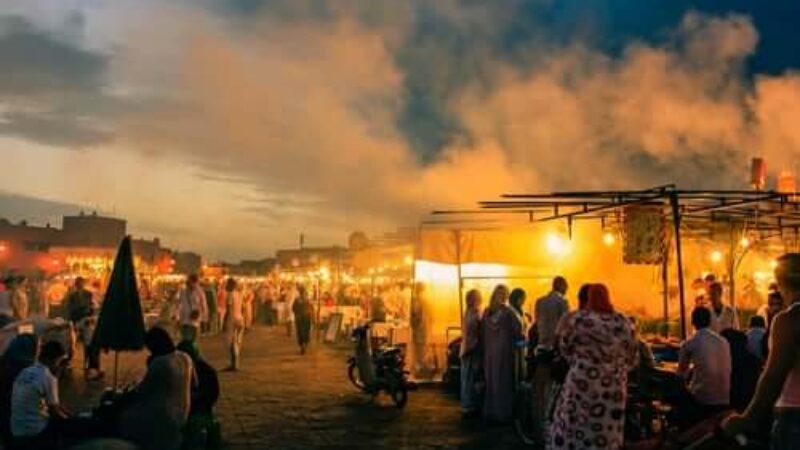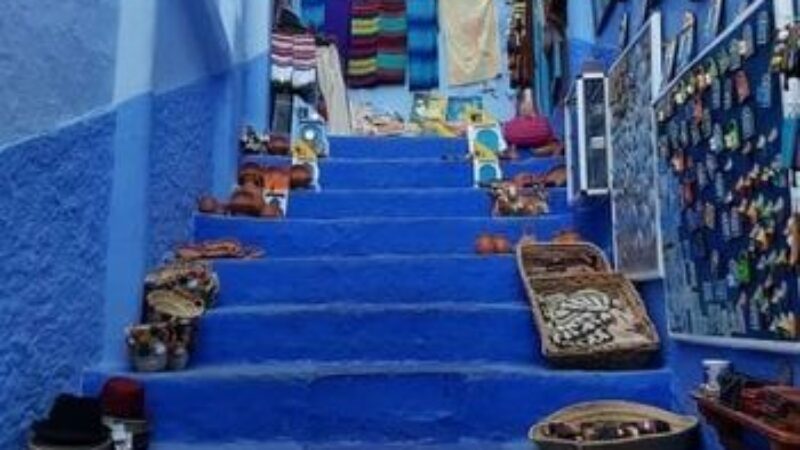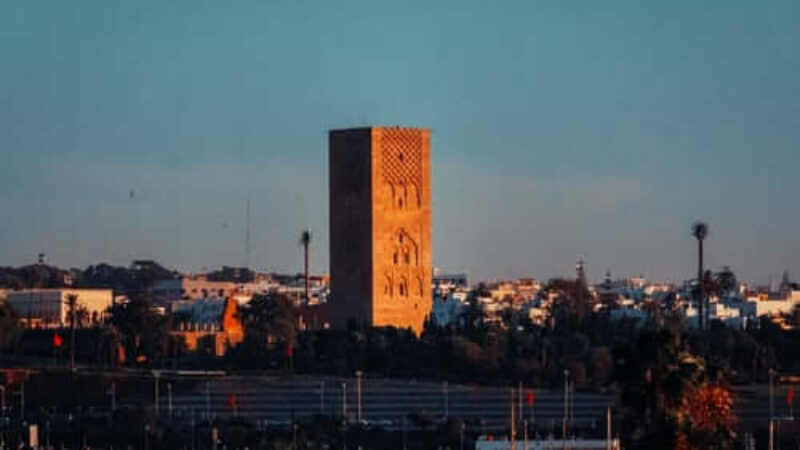Fez is the intellectual, religious, and artistic capital of the Cherifan Empire. It is the most perfect Muslim city in North Africa. The city obtained the rank of UNESCO World Heritage Site in 1980.
Less colorful and less aggressively seductive than Marrakech, it is more mysterious and exciting to discover. While Marrakech spreads out in full sunshine, in the plain, its wide squares covered with a turbulent and disparate crowd, Fez hides under a sky often gray, in a valley full of olive trees. The Fassis are aware of their culture and their good manners.
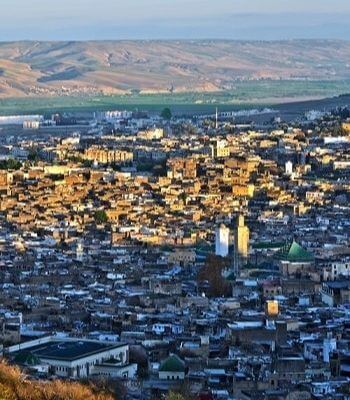
What To See In Fez:
A big day is necessary to visit Fez, even summarily. After the quick crossing of the new city, the Mellah and Fez Djedid (Fez the New), the morning will be devoted to the visit on foot of the medina, that is to say, Fez el Bali (Fez the Old), one of the most amazing cities of the Muslim world and perhaps the only one that has kept absolutely intact its medieval aspect. In the afternoon, and after enjoying a beautiful Fassi tagine, the tour of Fez which will reveal the plunging views of the city, the visit of the souks, and not to forget the discovery of the Karaouiyine mosque (the oldest university in the Muslim world, founded in 859) and the museums of the city.
What To Eat In Fez:
Generally, Fassie’s cuisine is a blend of the most refined flavors. It involves the senses of smell, taste, and sight. The tagine occupies the first rank. Fassi tagine is garnished with vegetables and fruits and colored with a multitude of spices. When you visit the city, you will be served three kinds of tagines; the tajine Mhamar, which means meat browned in melted butter, flavored basically with red pepper, cumin, ginger, and saffron. The tagine Maquelli, which means meat stir-fry, requires ginger and saffron. Third, tagine Mcharmel which means marinated meat, cooked with pepper and cinnamon. You will notice that each tagine dish has its own spices.
Fez will allow you to discover what the great families Fassies find tasty and beautiful through their long history. In addition to Fassi tagine, you will enjoy Fassi couscous which is made, like other Moroccan varieties of semolina, lamb meat, and vegetables, adding some sweet ingredients such as raisins. Fez is, also, the place to discover rich and sweet pastries, charcoal-grilled chicken, lamb, and vegetables; dishes made of contrasts born from the rich history and the diversity of the landscapes.
A Bit Of History:
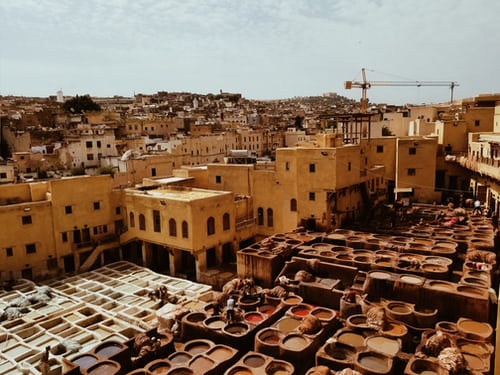
The Foundation Of A Capital City:
In 788, Fez was founded by Idriss ben Abdellah, the founder of the first Muslim dynasty in the Maghreb; the Idrissides. Leaving Volubilis, located about 50 km west of Fez, where his father had died, poisoned by an envoy of the Caliph of Baghdad Haroun al Rachid, Idriss left in search of a favorable location for the establishment of a capital. The valley of the Wadi Fez seduced him with its abundant white water and lush green banks. It is there that he decided to build his city.
As soon as he prepared to draw the outlines of it, a hermit, at least 150 years old, came to him and asked him what he came to do in these mountains. “I am coming,” replied Idriss, “to build a city where the Highest God will be worshipped, where his book will be read and his laws respected.” “In that case,” said the old man, “listen, I am speaking from the mouth of another hermit, who died more than a hundred years ago, that long before Islam shone on the earth, there was a magnificent city here called Sef. It was destroyed, but I know that a man will come, who will bear the name of Idriss and who will rebuild it in all its splendor. “I am that man” cried Idriss, and my city will be called Fez because everything has changed since Mohammed came. And he immediately began to dig the foundations.
Two Rival Cities:
Out of respect for an old Berber tradition that villages include several distinct hamlets, Idriss Il built two towns. He surrounded each of them with a wall. On the left bank of the wadi gathered around the founder, the chiefs, and the Arab warriors. In the district of the right bank found asylum the Berber tribes.
Soon the population received important reinforcements. 8,000 Andalusian families, fleeing the rigors of the Caliphs of Cordoba, came to take refuge in Fez. Idriss Il settled them in the right bank neighborhood, which he named Adoua el Andalous, the neighborhood of the Andalusians. Shortly afterward, 3,000 Arabs, coming from Kairouan, attracted perhaps by the reputation of holiness of Idriss or by the more material concern of making a fortune, arrived in Fez. They were housed in the district of the left bank which was then called Adoua el Karaouine, the district of the Kairouanese.
When Idriss the Builder died in 828, suffocated by a grain of grapes, Fez was thus composed of two twin but rival cities. Each had its chief, its mosque, its public buildings, its souks, its Fondouks. Between the two, lay the “no man’s land” where the Kairouanese and the Andalusians came to settle their quarrels.
The Golden Age:
In the 11th century, an Almoravid conqueror (a Berber dynasty who reigned over Morocco from 1055 to 1147), reunites the two cities in the same enclosure, without being able to reconcile them completely.
With the Almohads (12-13 century) Fez (Fez el Bali today) became a great religious, intellectual and commercial city. Its industries develop and multiply. Along the wadi, mills, tanneries, dyeing, copper, and pottery workshops are established by the hundreds.
The Merinides:
Under the Merinids (13 to 15 century) Fez reaches its apogee. In the middle of the 14th century. it counts nearly 200.000 inhabitants and becomes the capital of an immense empire which includes all of North Africa and Andalusia. While in Europe triumphs the Gothic art, the Moorish art is in full bloom in Fez. The sultans built sumptuous palaces, spacious hotels, mosques, harmonious madrasas that welcome foreign students, attracted by the reputation of the University of Fez.
According to the chroniclers of the time, the land is so generous around the city that the trees bear fruit in their first year and the harvest is done 40 days after sowing. The water that flows is so pure that a poet wrote: “Oh Fez, all the beauties of the earth are gathered in you! What blessings and goods have not been showered upon those who dwell in you! Is it your freshness that I breathe or is it the health of my soul? Are your waters white honey or silver? Who will paint these streams that weave their way through the earth and bring their waters to the places of assembly, to the squares, and to the paths?”
The Saadians And The Alaouites:
Around the middle of the 16th century, the Saadians (descendants of Muhammad) left Fez and preferred Marrakech as their capital. The prosperity of the city, abandoned by the sultans and left to anarchy, declined rapidly.
Under the Alaouites, a dynasty still in power today. Fez regains the favor of the sultans and at the same time a little life. Little by little, it regains its activity of the golden age. The local arts, whose traditions threatened to disappear, are revived. Palaces, mosques, madrasas are restored. Around the city, roads are traced. Hospitals, dispensaries, schools are created. Railroads connect Fez to Casablanca, Tangier, and Algeria. A modern city develops away from the old city and leaves for this one its integral character of the historical city.
Must-Visit Places In Fez:

Fez El Bali (the Oldest Fez):
Madrassa Mesbahia:
The door opens under a beautifully carved canopy. The interior presents around a two-story patio, charming decorative motifs.
Madersa Seffarine:
It is the oldest in Fez but it has been completely refurbished. AbdelKrim El Khattabi, the chief of the Rif region, was one of its most studious “Tolba” (student).
Bab Mahrouk:
This gate, built at the beginning of the 13th century, has a tragic history. As soon as it was built, it housed the pyre on which a Berber who had rebelled against the sultan was burned at the stake. This is why it is called Bab Mahrouk, the “burnt door”. Over the following centuries, it was from its battlements that the severed heads of defeated rebels hung.
Bab Guissa:
Built at the same time as Bab Mahrouk. Inside, an alley of Fez el Bali, which bypasses the mosque of Bab Guissa (18th century) enters Fondouk el Yhoudi, a district where the Jews were confined before the creation of the Mellah.
Fez Djedid (Fez the New):
Created in the 13th century by a Merinid sultan who established his palace there; flat city, with low houses.
Makina:
Former arms factory, built at the end of the 19th century by Sultan Moulay el Hassan (1873-1894) with the help of an Italian military mission. It consists of a vast series of vaulted chambers. Dar el Makina occupied the western side of the famous square of Fez Djedid, El Mechouar.
Great Mosque:
This mosque, which would be one of the most beautiful in Fez, communicates directly with the palace of the Sultan. Its minaret offers a pretty polychrome decoration.
Mellah:
Until the 13th century, the Jews were housed near Bab Guissa in the neighborhood that is still called Fondouk el Yhoudi. When Fez Jedid was built, they were ordered to move there. Many of them, who had interests in the medina, preferred to convert to the Muslim religion rather than abandoning their possessions; this explains the Jewish origin of some Fassite families. The others crammed into a special walled neighborhood near the palace of the sultan, who had promised his protection for a few extra taxes. This ghetto took the name of “Mellah”, which means “salt” because it was the Jews who emptied and salted the heads of the decapitated rebels before they were displayed on the city gates.
Madrasa Bou Anania
The madrasa Bou Anania was built in the middle of the 14th century. It is one of the most admirable productions of Merinide art. The most beautiful part of the monument is the courtyard. Its floor is paved with marble and onyx. Its walls, entirely covered with mosaics and carved plaster, are mounted on a large frieze of cedarwood, covered with Koranic inscriptions and sheltered by a canopy of extraordinary richness.
From the courtyard, from which it is separated by a bypass of the Fez wadi, you will see the prayer room with a floor lined with mats and its highly decorated mihrab. From there also, you will discover the minaret with its polished enamels.
Souk Attarine:
It is the souk of the grocers; narrow, colorful, very animated. The place where you will discover spices with amazing smells; a true feast for your senses, as the pleasure of your nose will be added to the pleasure of your sight.
Madarsa Attarine:
Raised in the 14th century, thirty years before Bou Anania, it is one of the most graceful madrasas of Fez. Its door, lined with copper, is equipped with a chiseled knocker. Its vestibule, its courtyard, and its prayer room, of less vast proportions than in Bou Anania but just as harmonious, are profusely decorated with zelliges (enameled ceramic mosaics), plaster, and carved wood. You can visit student rooms and climb on the terrace from where the view is interesting on the Karaouine mosque.
Karaouine Mosque:
This mosque was founded in the 9th century and was given its present dimensions in the 11th century. It was the largest mosque in North Africa, with a capacity of 22,000 worshippers. It was the seat of the famous university which, in the 14th century, counted up to 8,000 students and which today, after an almost complete decadence, has regained a certain vitality.
Dar Batha:
Dar Batha is a modern palace converted into a museum of Moroccan arts. Very beautiful specimens of Moroccan art are exposed there: carved wood, fabrics, embroidery, jewelry, carpets, bindings, ancient ceramics, etc…. In one of the rooms was gathered a curious collection of weapons. Another room contains the cage in which the rebel Bou Hamara, unfortunate adversary of Sultan Moulay Hafid, was exposed to the people before being thrown to the lions.
Merinides Tombs (14 century):
The mausoleums that covered the ashes of the Merinid sultans are in ruins and are of little interest, but from their surroundings, one has an admirable view of Fez el Bali, with its ramparts and minarets. Really, the panorama of the medina, from there, is very beautiful.
Madarsa Cherratine:
It is the most recent (17th century) and the largest madrasa of Fez. It can accommodate 150 students. Of less harmonious proportions than its elders, it nevertheless presents charming details; its door with bronze cladding and equipped with a chiseled knocker, the sculpted ceiling of its vestibule, its courtyard with superimposed galleries.
Zaouia Of Moulay Idriss:
A zaouia is a sanctuary placed under the patronage of a saint. It is usually the seat of a religious brotherhood. The zaouia of Moulay Idriss was one of the holiest in Morocco because it houses the tomb of Idriss II, the founder of Fez. At the main entrance of the zawiya, you can see the interior of the sanctuary with its rain of chandeliers and its astonishing collection of clocks. It is said that these clocks were offered by the sultans at their advent and that the oldest dates back several centuries.
Nejjarine Square:
This is one of the most charming corners of old Fez. At the end of the square, you will discover the Fondouk Nejjarine, whose entrance, very decorated, is surmounted by a magnificent canopy. The Nejjarine fountain is s worth a stop and a look; an intricately constructed fountain that offers a pretty decoration of zelliges.
Kissariat:
The Kissariat is the commercial center of the big cities in Morocco. In Fez, it is a very picturesque neighborhood of covered alleys and closed at night by heavy doors. There you can find the different specialties of the finery and luxury goods. It is the right place to find typically Moroccan souvenirs for those you love best!

